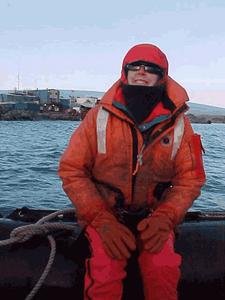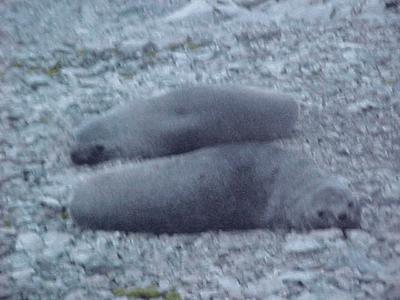11 April, 2003
This morning started out with a research team meeting at 8:00AM. We
begin each morning just like that. This is a time when each team
member gives their agenda for the day to everyone else so that we all
know what the others are doing and so that in case someone needs to
be found, they can be easily located. It also gives our principal
investigator an idea on how all of the research projects and
experiments are going.
10AM- The Laurence M. Gould leaves Palmer Station to go on a fishing
cruise to gather samples for their experiments. They will return in
3 days. I had Boating II class. I failed Boating II because I never
could get the motor started! The best part about learning new
skills is that there is always another chance. So, tomorrow I will
try to get the motor started. I now have a goal. I don't want to
leave Antarctica until I have learned to start the engine of a
motorboat. Another TEA recently told me no one is an expert at
something the first time.
Every time a boat leaves the dock, there must be two people aboard
that have passed boating certification and have radios. Radios are
taken along for safety measures. One person radios that we are in
the boat and are about to leave Palmer and where we are headed. We
radio again when we reach our destination so that the station knows
we have safely arrived at the location we intended. Every 30 minutes
that a boat is out, someone has to radio in to let the station know
that everyone is o.k. If a boating party has not radioed in for 30
minutes, the station will radio to them. If there is no answer,
there is an immediate search and rescue party sent out to find the
group. No one is allowed to go boating alone. Every boat must have
at least two people in it and both must be boating certified.
We went out to Christine Island for several research team members to
dive and collect samples. While we were there, I received more
Boating II training. Dive tenders not only help the divers with
their gear, they also keep watch while the divers are in the water by
following the bubbles that rise to the surface from their regulators.
Once, the Boating Coordinator, my boating instructor, and I lost the
bubbles and with the surf, we had a hard time trying to find them.
We circled around and around the area our divers were supposed to be
diving. We were both relieved when we finally found them.
I also saw my first leopard seal!!! I could tell by the profile it
was a leopard.
On the way back to the station, I got to drive the boat!!!
Around 3PM, several of the team members were weary from a week's
work. They decided to take a boating outing and asked if I'd like to
go. Of course, I said I would love to go. We went to another side
of Anver's Island to the Old Palmer Station. Palmer Station was
originally a British station that wasn't much more than a hut.
Later, large metal containers were put there as housing for
construction workers while they built the current Palmer Station.
After the current station was finished, the old station was
maintained for years as a survival station in case of an abandon
station at Palmer due to an emergency or fire. Now, Palmer is large
enough not to have to do that. There are enough buildings here to
keep everyone until help can arrive or construction is completed due
to damage.
Palmer Station was named after Nathaniel B. Palmer, the first
American to reach Antarctica. There is also a research, ice breaking
vessel named after him. The Laurence M. Gould is ice strengthened,
but it is not an icebreaker.
We went hiking at Old Palmer. Anver's Island is a very rocky, small
pebbly kind of place and you have to be very careful. I twisted my
right ankle. I checked the stone I was going to step on and it
seemed secure, then when I actually put weight on it, the stone moved
and my ankle was twisted from the turning of the stone. I fell
hiking, too. I am still learning how to maneuver in my new gear.
The issue boots that I am wearing are very bulky. It has been
difficult for me to learn to use them properly. I thought I was
lifting my foot high enough to step over a boulder, but it takes more
energy to lift with the bulky boots. I misjudged my lift, which
caused me to lose my balance, and I fell about 3 feet or so down the
side of the hill. Now, I know that doesn't sound far, but when the
terrain is nothing but boulders, it can be quite a jolt.
Our hike led us to a place called Loudwater Cove. Loudwater Cove was
appropriately named due to calving glaciers close by that make loud
crashing noises as they hit the water.
Tonight after dinner I had GASH. GASH is clean-up duty. I was
assigned dish washing.
Glenn is Palmer Stations' Science Technician. I went to his office
tonight after GASH to talk to him. I had a lot of questions I wanted
to ask him about meteorology and his instruments. Palmer has an
instrument shelter in its yard almost exactly like the one that the
GLOBE program uses. His protocols are also almost exactly like the
GLOBE program protocols. Glenn uses a cloud chart to determine what
type of clouds and the percentage of cloud cover at Palmer Station.
He records any precipitation and the type of precipitation- rain,
sleet, and snow. One of his instruments record wind speed. Two
instruments record the barometric pressure- the aneroid barometer and
the microbarograph. All instruments record data 24 hours a day.
Each night at midnight GMT, Greenwich Mean Time, he has to radio in
to England the data he has collected for the day which is similar to
the GLOBE program's e-mail database that students complete daily.
Whew! I'm tired now. What a busy day!

The Laurence M.Gould leaves for its fishing cruise. Part of this mission will include retieving some moorings that have strayed.

In the zodiac ready to depart

I am radioing in that we are about to depart Palmer.

Away we go!

The glacier behind Palmer Station called Marr Ice Piedmont.

The Palmer weather station.

This is the instument shelter that records that same data as the GLOBE program instrument shelters record.

Here I am all geared up for the severe weather exposure I will receive.

Fur seals at Old Palmer.

Do you see anything in this picture? Look closely. Isn't the giant petel at Loudwater Cove camouflaged well?

A close-up view of the wind speed instrument.
Contact the TEA in the field at
.
If you cannot connect through your browser, copy the
TEA's e-mail address in the "To:" line of
your favorite e-mail package.
|
